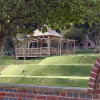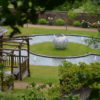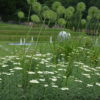May & Watts Garden Design – Enhance Your Garden With Design
Celebrating 25 years of Designing Beautiful Garden for Modern Living
In 2011, Diana May and Mark Watts of May & Watts Garden Design were commissioned to design a contemporary scheme for the walled garden.
The sloping, south facing walled garden is situated in the ‘foothills’ of the property, and this genius loci provides the initial inspiration for the design, linking this area with the wider garden. Terraces have been used in the Himalayan foothills for crop production for centuries, and it was these landforms that inspired the new terraces of the Walled Garden, as well as referencing its historic crop production. The curvilinear contours of the landform terraces are pleasingly organic in nature, making an asset of a potentially difficult sloping site, both in function and form,
A circular pool containing an island reached by a turf bridge reflects the curves of the terraces. The pool contains eight fountains; a colonnade of movement and sound, creating an island room.
A circular standing of trees (Betula utilis var. jacquemontii – Himalayan Birch) is sited over three terraces.
Four elliptical island beds rise up the terraces forming a cascade of flower; the clean whites ofSidalcea candida, the pale rosy hue of Stokesia laevis ‘Träumeri’, the icy blues tones of Iris ‘Blue Shimmer’, and sparkling lemon flashes of Leucanthemum x superbum ‘Sonnnenschein’ of these Pale Beds create a vision of tumbling water catching the sunrays.
The top terrace references the more traditional aspects of the walled garden. A small orchard of apple trees (an important crop in Kent and the Himalayas) encircles a path that leads to a cloistered hut embowered with roses and vines that offers some welcome shade and stunning vistas across the garden and beyond.
A path from the ‘hut’ designed by Mark Watts leads to a small formal vegetable garden edged with box which follows the contour of the terrace, making use of all available space.
At the bottom of the garden there is a long hydrangea walk under planted with peonies which provides flowering interest from mid-summer onwards.
For further information, please go to Riverhill Gardens
Riverhill House was bought in 1840 by John Rogers, a scholar, scientist, botanist, Fellow of the Royal Society, friend of Charles Darwin, and one of the first members of the Royal Horticultural Society. He was a patron of plant hunters and sponsored expeditions to find rare and exotic seeds which he hoped to cultivate at Riverhill – a perfect place to introduce new plants due to its sheltered situation and lime free hillside. These plant hunters went to the Himalayas to bring back plants which can still be seen at Riverhill today.
The estate is managed by Edward (great, great, great grandson of John Rogers) and his wife Sarah. Four generations of the Rogers family lived at Riverhill.





